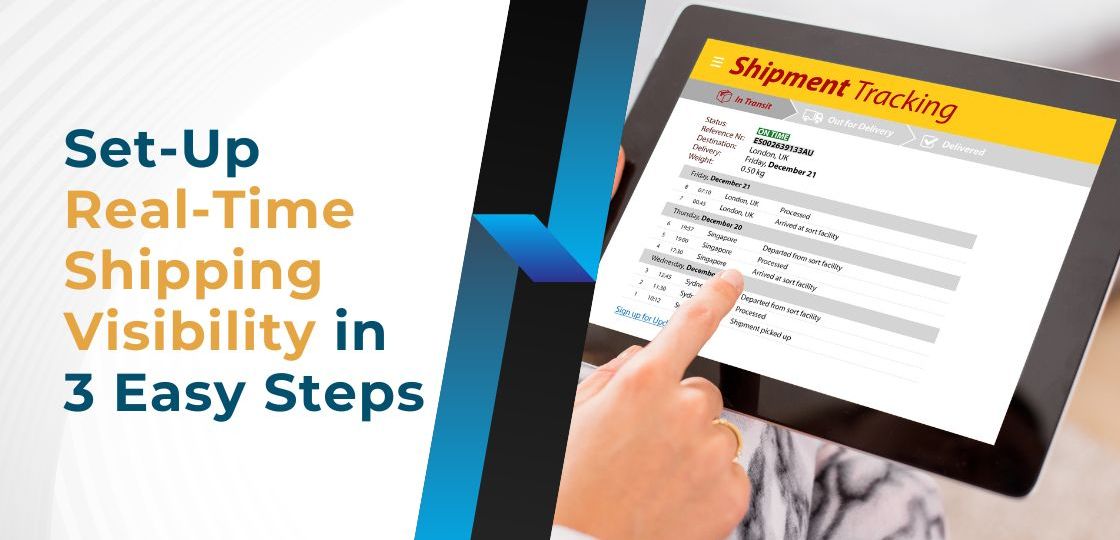
Knowing where all your shipments are and their status is crucial for efficiently managing your distribution channels . However, achieving true real-time visibility can be a challenge, especially when you are utilizing multiple carriers.
In this article, we’ll outline a few expert tips and recommend an industry-leading solution to streamline and display all your shipment details. Whatever the size and type of your business, if you are shipping goods, these tips are an invaluable starting point. Read on to learn of ways to have complete transparency of all your shipments.
Importance of Real-Time Visibility of Your Shipments
Real-time visibility refers to having up-to-date information on the location and status of shipments as they progress on their journey to the intended receiver. This is extremely valuable for several reasons:
- Improved Customer Service – With real-time tracking & event data, customer service teams can proactively notify their clients and the receivers of the shipments of any delays or issues. Managing delivery expectations greatly improves client & consumer satisfaction.
- Faster Problem Resolution – Real-time status alerts allow logistics teams to quickly identify and troubleshoot problems if a shipment gets delayed at any point. Managing exceptions goes hand in hand with managing the carriers and their performance..
- Enhanced Planning – When you have visibility on where all your shipments are at all times with all carriers, you can optimize services, costs, and carriers. Detailed interrogation of distribution data enables systems to be recalibrated, enhancing performance.
- Accountability – Transparency of all shipping data with a complete audit trail ensures full accountability for all parts of the distribution chain. Powerful live reporting dashboards displaying comparative KPIs are key management tools.
- Reduced Claims & Lower Returns – Fully accountable and transparent distribution channels significantly reduce the number of claims for damage, loss and delayed shipments. Further ensuring clients & receivers expectations are managed the level of return shipments are greatly reduced. This saves time, money and headaches.
- Automation—Systems with enhanced automation functionality trigger actions such as messaging a receiver of the delivery day and the one-hour delivery window, easing the demands on customer service teams. Many automation functions are available, and the levels of sophistication are constantly evolving, saving time, money, staff, and inconvenience.
- Options – Needless to say there are numerous shipment monitoring options to alleviate repetitive tasks or to enhance functionality. These include auto requests to carriers to re-direct a shipment or update an address or contact telephone number. Enhanced monitoring tools include tamper alerts, temperature alerts, out-of-geo-region or route alerts, weather alerts, etc. Monitoring options can all be displayed on one or more of your customisable dashboards.
Steps to Set Up Real-Time Shipping Visibility
Here are the 3 steps to set up real-time logistics visibility explained in more detail:
I. Technology Integration
The first key step is integrating your logistics data with technologies that can track shipments and deliver insights. This may involve connecting transportation management systems, GPS devices on assets, and ERP systems so they communicate seamlessly. Properly integrating these platforms lays the foundation for unified data collection across the supply chain. It ensures logistics partners can access the same tracking platforms to provide updates. Integrations take time to do right but are essential for powering future visibility.
II. Data Management and Analytics
Data flowing in from multiple sources must be organized and structured in a central data management system. This can be simple databases or advanced logistics platforms. It allows the configuring of rules around data storage, standardization, and security. Building out reporting and analytic tools that transform raw data into dashboards and KPIs is key. Understanding order statuses, shipping exceptions, and delivery trends enables proactive management. Over time, advanced analytics can also surface optimization opportunities across the network.
III. Collaboration and Communication
Real-time visibility depends on collaboration between supply chain stakeholders. It requires empowering internal teams and external logistics providers with access to the right tracking information. This may involve portals or communication tools that update everyone consistently. Proper change management makes users comfortable with new systems and seamlessly escalates appropriate issues. Advanced notifications keep managers apprised of delays, answering customer questions faster. By fostering collaboration, logistics become more aligned and responsive to clients’ needs for transparency.
Gain Unparalleled Visibility with Logilink
Setting up real-time logistics visibility can be easy and inexpensive. Logilink’s Logi Consignor shipping platform can help you achieve this with ease.
Logi Consignor seamlessly connects with your various transportation systems, warehouses, and partners as a fully integrated supply chain solution. It effortlessly collects tracking data across modes to provide a unified view of all shipments.
Logi Consignor’s powerful reporting and analytics tools transform this raw data into actionable insights. Its customizable dashboards allow monitoring order milestones and exceptions from a single dashboard. Managers can proactively optimize routes and capacities based on network KPIs.
Logi Consignor also simplifies collaboration with features like portal access, document exchange and task management. This facilitates faster issue resolution.
Overall, Logi Consignor eliminates the hassles of integrating disparate systems. Contact Logilink today for a demonstration on how their industry-leading shipping platform can deliver the visibility you need to exceed customer expectations.
